Assessment of the Potential of a Front Brake Light to Prevent Crashes and Mitigate the Consequences of Crashes at Junctions
Abstract
1. Introduction
2. Material
3. Method
3.1. Reconstruction (“Baseline”)
3.2. Counterfactual Simulation (“What-If”, “Treatment”)
- Scenario (a): The non-priority car is stationary, and the brake pedal is depressed. The FBL is activated. As soon as the driver starts to move, the FBL is deactivated. The priority car is now requested to react.
- Scenario (b): The non-priority car approaches the junction at a constant speed without braking. The FBL is deactivated. A reaction of the priority car is requested at the point where it is clear that the non-priority car is entering the priority car’s lane.
- Scenario (c): The non-priority car approaches the junction at a constant speed and starts to accelerate. The FBL is deactivated. A reaction of the priority car is requested at the point where it is clear that the non-priority car is entering the priority car’s lane.
- Scenario (d): The non-priority car approaches the junction and is braking but not stopping at the stop line. The FBL is activated all the time. A reaction of the priority car is requested at the point where it is clear that the non-priority car is entering the priority car’s lane.
- Scenario (e): The non-priority car is braking first and then travelling at constant speed to the junction. The FBL is activated during the braking phase but is deactivated when driving at constant speed. A reaction of the priority car is requested at the point where it is clear that the non-priority car is entering the priority car’s lane.
- Scenario (f): The non-priority car is braking first and then accelerating to the junction. The FBL is activated during the braking phase but is deactivated when driving at constant speed. A reaction of the priority car is requested at the point where it is clear that the non-priority car is entering the priority car’s lane.
3.3. Strategy
3.3.1. Reaction-Braking Time
3.3.2. Visibility of the FBL
3.4. Safety Performance Assessment
4. Results
4.1. Pre-Collision Behaviour in the Baseline
4.2. FBL Visibility
4.3. Avoidance and Mitigation
4.4. Collision Speed and Change in Velocity
5. Discussion
6. Limitations
7. Conclusions
Author Contributions
Funding
Data Availability Statement
Conflicts of Interest
Abbreviations
| ABS | Anti-lock Braking System |
| AEB | Emergency Braking Assist |
| CEDATU | Central Database for In-Depth Accident Study |
| FBL | Front Brake Light |
| FCW | Frontal Collision Warning |
| FOT | Field Operational Tests |
| LTAP/LD | Left Turn Across Path/Left Direction |
| LTAP/OD | Left Turn Across Path/Opposite Direction |
| NCAP | New Car Assessment Programme |
| NDS | Naturalistic Driving Study |
| SCP | Straight Crossing Path |
| SD | Standard Deviation |
Appendix A
| Accident Type | Pictogram | Description |
|---|---|---|
| 311 RT/SDRE |  | Collision with a vehicle which is turning right at a junction (Right Turn/Same Direction Rear End) |
| 312 RT/SDR |  | Collision of a vehicle which is turning right with another vehicle which is passing by and moving straight at a junction (Left Turn/Same Direction Right) |
| 313 RT/RTSD |  | Lateral collision between two vehicles turning right at the same time at a junction (Right Turn/Right Turn Same Direction) |
| 321 LT/SDRE |  | Collision with a vehicle which is turning left at a junction (Left Turn/Same Direction Rear End) |
| 322 LT/SDL |  | Collision of a vehicle which is turning left with another vehicle which is overtaking or passing by at a junction (Left Turn/Same Direction Left) |
| 323 LT/LTSD |  | Lateral collision between two vehicles turning left at the same time at a junction (Left Turn/Left Turn Same Direction) |
| 331 UT/SDJ |  | Collision at a junction between a vehicle making a u-turn from the right lane and a vehicle travelling straight ahead on the left lane (U-Turn/Same Direction Junction) |
| 332 UD/SD |  | Collision at mid-block between a vehicle making a u-turn from the right lane and a vehicle travelling straight ahead on the left lane |
| 391 OTSD |  | Other accidents when turning or making a u-turn, travelling in the same direction (Other Turn/Same Direction) |
| 411 LTAP/OD |  | Collision between a vehicle turning left and another vehicle coming from the opposite direction and travelling straight ahead (Left Turn Across Path/Opposite Direction) |
| 421 LT/LTOD |  | Lateral collision between two vehicles turning left in opposite directions (Left Turn/Left Turn Opposite Direction) |
| 431 RT/LTOD |  | Collision between a vehicle turning right and another vehicle turning left coming from the opposite direction (Right Turn/Left Turn Opposite Direction) |
| 451 RT/OD |  | Collision between a vehicle turning right and another vehicle (bicycle, tram) travelling in the opposite direction on a special lane (e.g., cycle lane, tram, right of way) (Right Turn/Opposite Direction) |
| 461 UT/ODJ |  | Collision between a vehicle making a U-turn and another vehicle travelling in the opposite direction at a junction (U-Turn/Opposite Direction Junction) |
| 462 UT/OD |  | Collision between a vehicle making a U-turn and another vehicle travelling in the opposite direction at mid-block |
| 491 OT/OD |  | other accidents when turning or making a U-turn, travelling in opposite direction (Other Turn/Opposite Direction) |
| 511 SCP |  | Collision at a junction between two vehicles travelling at right angles to each other (Straight Crossing Path) |
| 591 SCPO |  | Other collision at a junction between two vehicles travelling at right angles to each other (Straight Crossing Path Other) |
| 611 RT/LD |  | Collision at a junction of a vehicle which is turning right and a vehicle coming from left and is crossing straight (Right Turn/Left Direction) |
| 612 LT/RD |  | Collision at a junction of a vehicle which is turning left and a vehicle coming from right and is crossing straight (Left Turn/Right Direction) |
| 621 RT/RD |  | Collision at a junction of a vehicle which is turning right and a vehicle coming from right and is crossing straight (Right Turn/Right Direction) |
| 622 LTAP/LD |  | Collision at a junction of a vehicle which is turning left and a vehicle coming from left and is crossing straight (Left Turn Across Path/Left Direction) |
| 631 RT/RT |  | Collision at a junction of a vehicle which is turning right and another vehicle coming from the left, also turning right (Right Turn/Right Direction) |
| 632 LT/LTRD |  | Collision at a junction between a vehicle turning left and another vehicle coming from the left, also turning left (Left Turn/Left Turn Right Direction) |
| 633 RT/LTRD |  | Collision at a junction of a vehicle which is turning right and another vehicle coming from the right and turning left (Right Turn/Left Turn Right Direction) |
| 691 OT |  | Other turning accidents—collisions between vehicles turning either right or left (Other Turning/Left or Right) |
Appendix B
| Accident Site | Minor Injury | Severe Injury | Fatal Injury | Total |
|---|---|---|---|---|
| Urban | 10,351 | 1789 | 56 | 12,196 |
| Rural | 24,758 | 1596 | 16 | 26,370 |
| Total | 35,109 | 3385 | 72 | 38,566 |
| Road Condition | Minor Injury | Severe Injury | Fatal Injury | Total |
|---|---|---|---|---|
| Dry | 26,727 | 2631 | 56 | 29,414 |
| Adverse road (wet, snow/snow slush) | 8382 | 754 | 16 | 9152 |
| Total | 35,109 | 3385 | 72 | 38,566 |
| Light Condition | Minor Injury | Severe Injury | Fatal Injury | Total |
|---|---|---|---|---|
| Daylight | 25,665 | 2474 | 55 | 28,194 |
| Darkness, Twilight/Dawn | 4920 | 547 | 15 | 5482 |
| Artificial light | 4524 | 364 | 2 | 4890 |
| Total | 35,109 | 3385 | 72 | 38,566 |
| Accident Type | Minor Injury | Severe Injury | Fatal Injury | Total |
|---|---|---|---|---|
| RT/SDRE | 907 | 15 | 922 | |
| RT/SDR | 294 | 21 | 315 | |
| RT/RTSD | 74 | 3 | 77 | |
| LT/SDRE | 1249 | 69 | 1318 | |
| LT/SDL | 1174 | 117 | 5 | 1296 |
| LT/LTSD | 77 | 1 | 78 | |
| UT/SDJ | 190 | 27 | 217 | |
| OTSD | 352 | 16 | 1 | 369 |
| LTAP/OD | 6489 | 834 | 10 | 7333 |
| LT/LTOD | 68 | 5 | 73 | |
| RT/LTOD | 109 | 6 | 115 | |
| UT/ODJ | 119 | 15 | 134 | |
| OT/OD | 234 | 18 | 252 | |
| SCP | 14,103 | 1310 | 35 | 15,448 |
| SCPO | 206 | 20 | 226 | |
| RT/LD | 1352 | 87 | 4 | 1443 |
| LT/RD | 1381 | 75 | 3 | 1459 |
| RT/RD | 454 | 37 | 491 | |
| LTAP/LD | 5263 | 649 | 14 | 5926 |
| RT/RT | 56 | 4 | 60 | |
| LT/LTRD | 388 | 20 | 408 | |
| RT/LTRD | 254 | 15 | 269 | |
| OTLR | 316 | 21 | 337 | |
| All junction accidents | 35,109 | 3385 | 72 | 38,566 |
| All other accidents | 54,546 | 4565 | 404 | 59,515 |
| Total | 89,655 | 7950 | 476 | 98,081 |
Appendix C
| Accident Type | Injury Severity | Safety Performance | Reaction Time 0.5 s | Reaction Time 1.0 s | Reaction Time 1.5 s |
|---|---|---|---|---|---|
| LTAP/OD | Fatal | Baseline | 10 | 10 | 10 |
| FBL visible | 10 | 10 | 10 | ||
| Preventable | 0 | 0 | 0 | ||
| Influenceable | 5 | 1 | 0 | ||
| No effect | 5 | 9 | 10 | ||
| Severe | Baseline | 19 | 19 | 19 | |
| FBL visible | 19 | 19 | 19 | ||
| Preventable | 4 | 3 | 3 | ||
| Influenceable | 5 | 3 | 0 | ||
| No effect | 10 | 13 | 16 | ||
| Minor | Baseline | 40 | 40 | 40 | |
| FBL visible | 40 | 40 | 40 | ||
| Preventable | 7 | 3 | 3 | ||
| Influenceable | 18 | 8 | 4 | ||
| No effect | 15 | 29 | 33 | ||
| Total | Baseline | 69 | 69 | 69 | |
| FBL visible | 69 | 69 | 69 | ||
| Preventable | 11 | 6 | 6 | ||
| Influenceable | 28 | 12 | 4 | ||
| No effect | 30 | 51 | 59 | ||
| SCP | Fatal | Baseline | 11 | 11 | 11 |
| FBL visible | 1 | 1 | 1 | ||
| Preventable | 0 | 0 | 0 | ||
| Influenceable | 0 | 0 | 0 | ||
| No effect | 11 | 11 | 11 | ||
| Severe | Baseline | 20 | 20 | 20 | |
| FBL visible | 7 | 7 | 7 | ||
| Preventable | 1 | 0 | 0 | ||
| Influenceable | 2 | 1 | 0 | ||
| No effect | 17 | 19 | 20 | ||
| Minor | Baseline | 37 | 37 | 37 | |
| FBL visible | 9 | 9 | 9 | ||
| Preventable | 2 | 2 | 0 | ||
| Influenceable | 3 | 1 | 3 | ||
| No effect | 32 | 34 | 34 | ||
| Total | Baseline | 68 | 68 | 68 | |
| FBL visible | 17 | 17 | 17 | ||
| Preventable | 3 | 2 | 0 | ||
| Influenceable | 5 | 2 | 3 | ||
| No effect | 60 | 64 | 65 | ||
| LTAP/LD | Fatal | Baseline | 13 | 13 | 13 |
| FBL visible | 12 | 12 | 12 | ||
| Preventable | 4 | 3 | 0 | ||
| Influenceable | 7 | 3 | 4 | ||
| No effect | 2 | 7 | 9 | ||
| Severe | Baseline | 17 | 17 | 17 | |
| FBL visible | 9 | 9 | 9 | ||
| Preventable | 3 | 3 | 3 | ||
| Influenceable | 5 | 3 | 1 | ||
| No effect | 9 | 11 | 13 | ||
| Minor | Baseline | 33 | 33 | 33 | |
| FBL visible | 23 | 23 | 23 | ||
| Preventable | 13 | 8 | 6 | ||
| Influenceable | 6 | 9 | 6 | ||
| No effect | 14 | 16 | 21 | ||
| Total | Baseline | 63 | 63 | 63 | |
| FBL visible | 44 | 44 | 44 | ||
| Preventable | 20 | 14 | 9 | ||
| Influenceable | 18 | 15 | 11 | ||
| No effect | 25 | 34 | 43 | ||
| Total | Fatal | Baseline | 34 | 34 | 34 |
| FBL visible | 23 | 23 | 23 | ||
| Preventable | 4 | 3 | 0 | ||
| Influenceable | 12 | 4 | 4 | ||
| No effect | 18 | 27 | 30 | ||
| Severe | Baseline | 56 | 56 | 56 | |
| FBL visible | 35 | 35 | 35 | ||
| Preventable | 8 | 6 | 6 | ||
| Influenceable | 12 | 7 | 1 | ||
| No effect | 36 | 43 | 49 | ||
| Minor | Baseline | 110 | 110 | 110 | |
| FBL visible | 72 | 72 | 72 | ||
| Preventable | 22 | 13 | 9 | ||
| Influenceable | 27 | 18 | 13 | ||
| No effect | 61 | 79 | 88 | ||
| Total | Baseline | 200 | 200 | 200 | |
| FBL visible | 130 | 130 | 130 | ||
| Preventable | 34 | 22 | 15 | ||
| Influenceable | 51 | 29 | 18 | ||
| No effect | 115 | 149 | 167 |
Appendix D
Appendix D.1. LTAP/OD Accidents


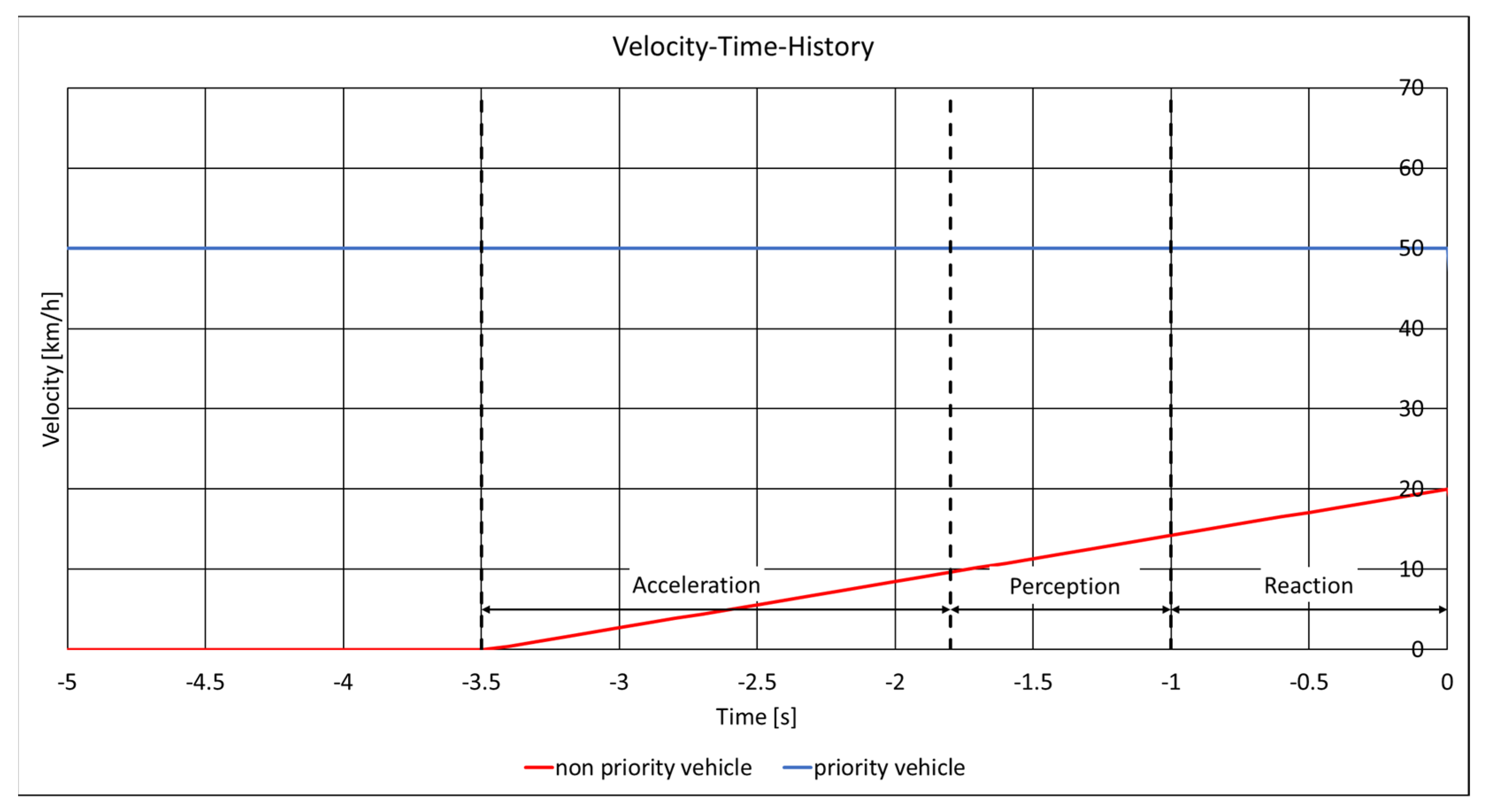
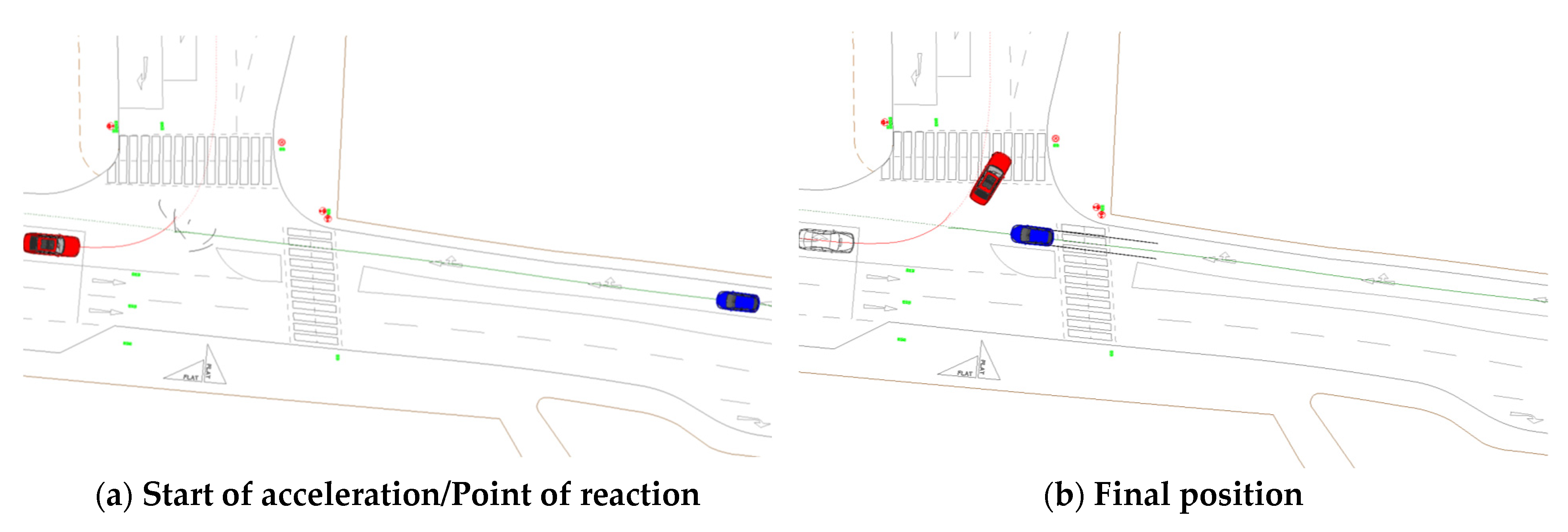
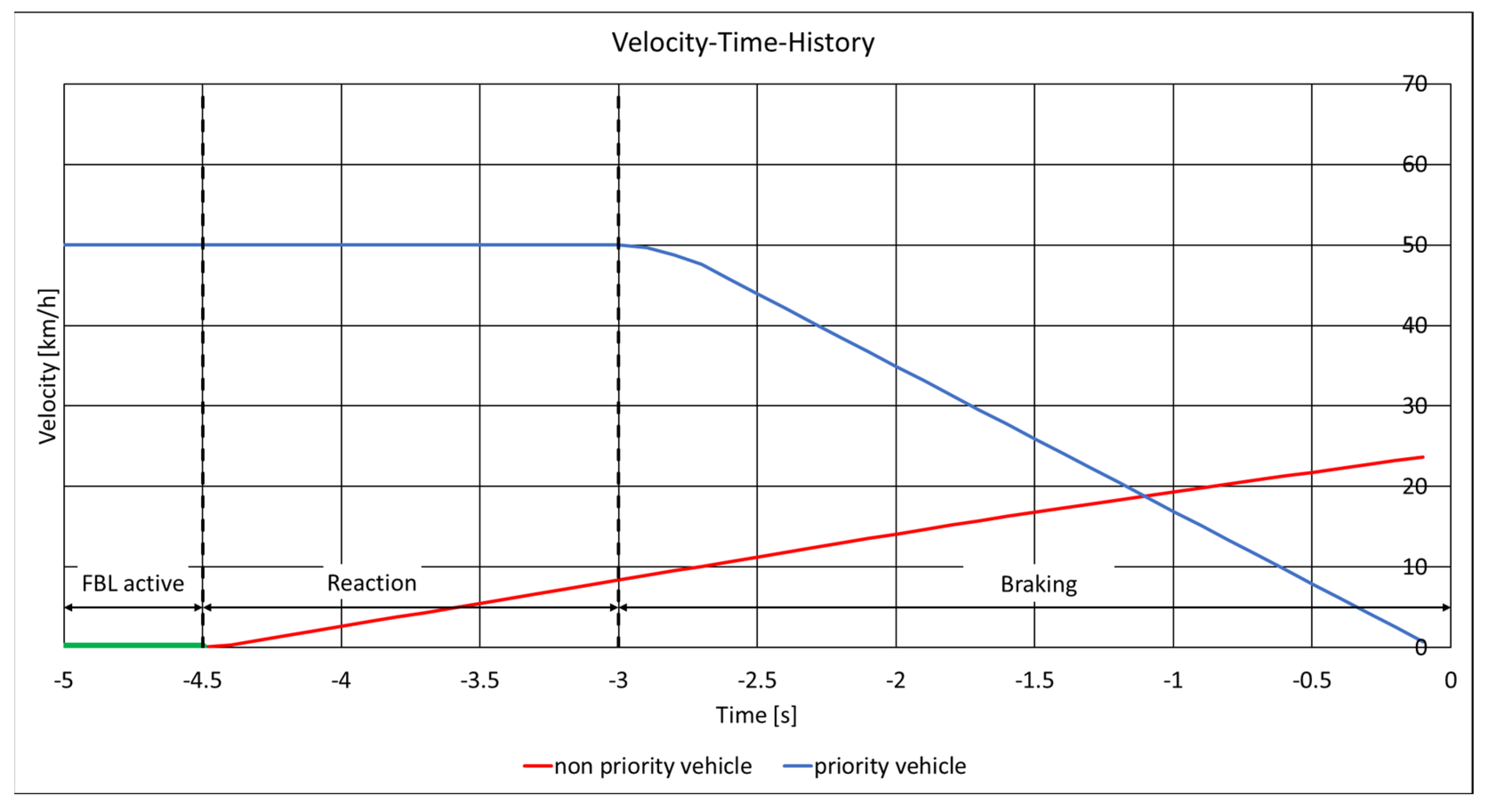
Appendix D.2. LTAP/LD Accidents
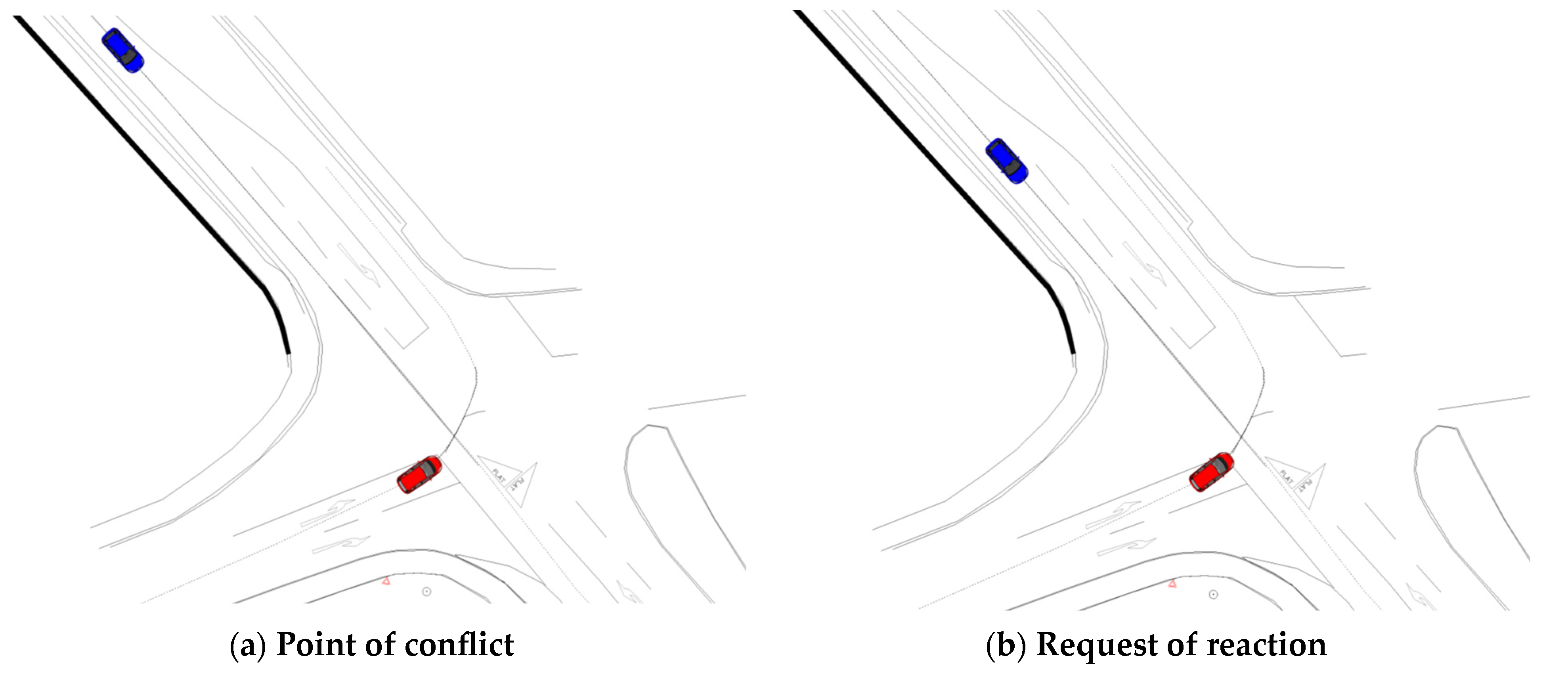
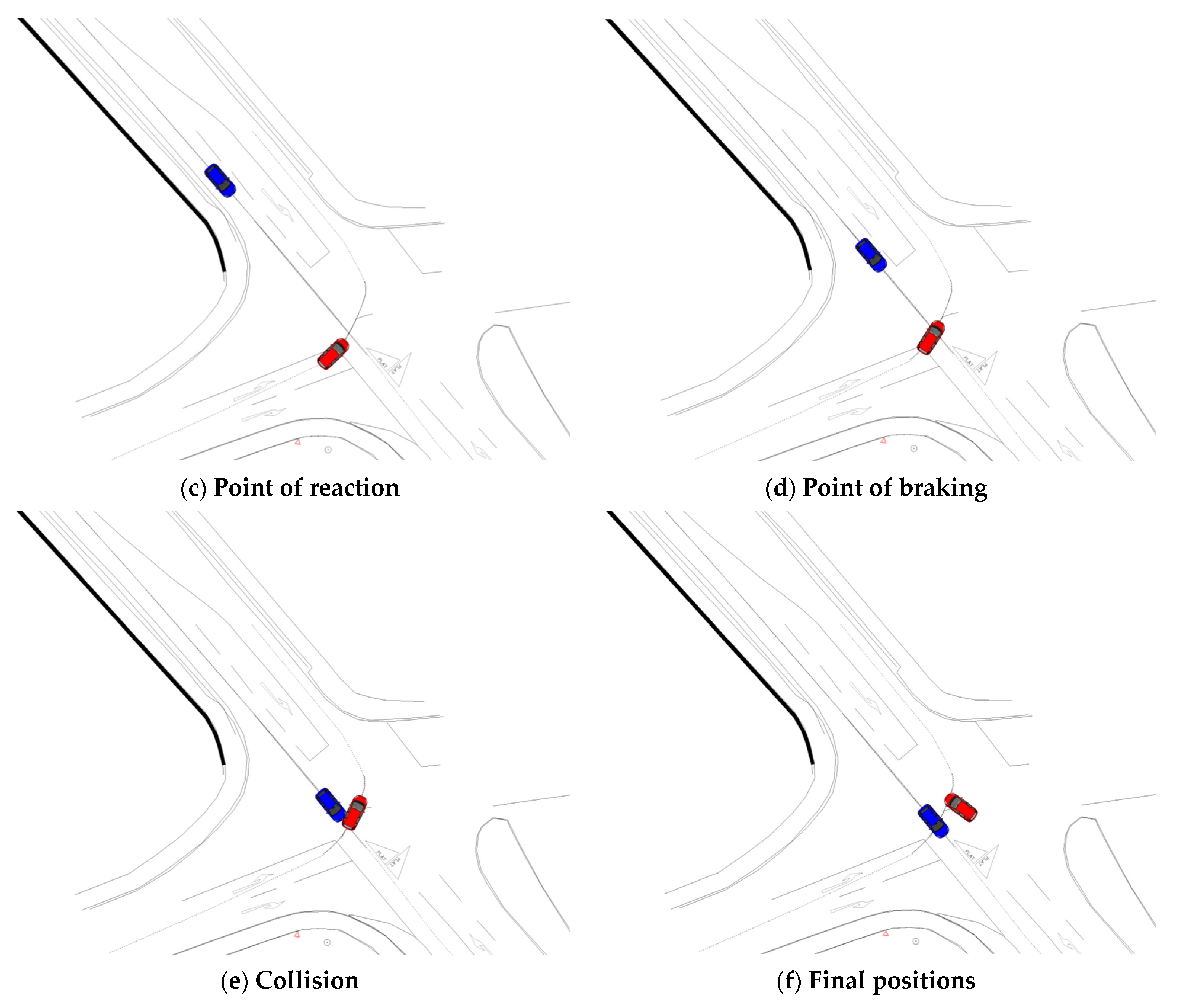
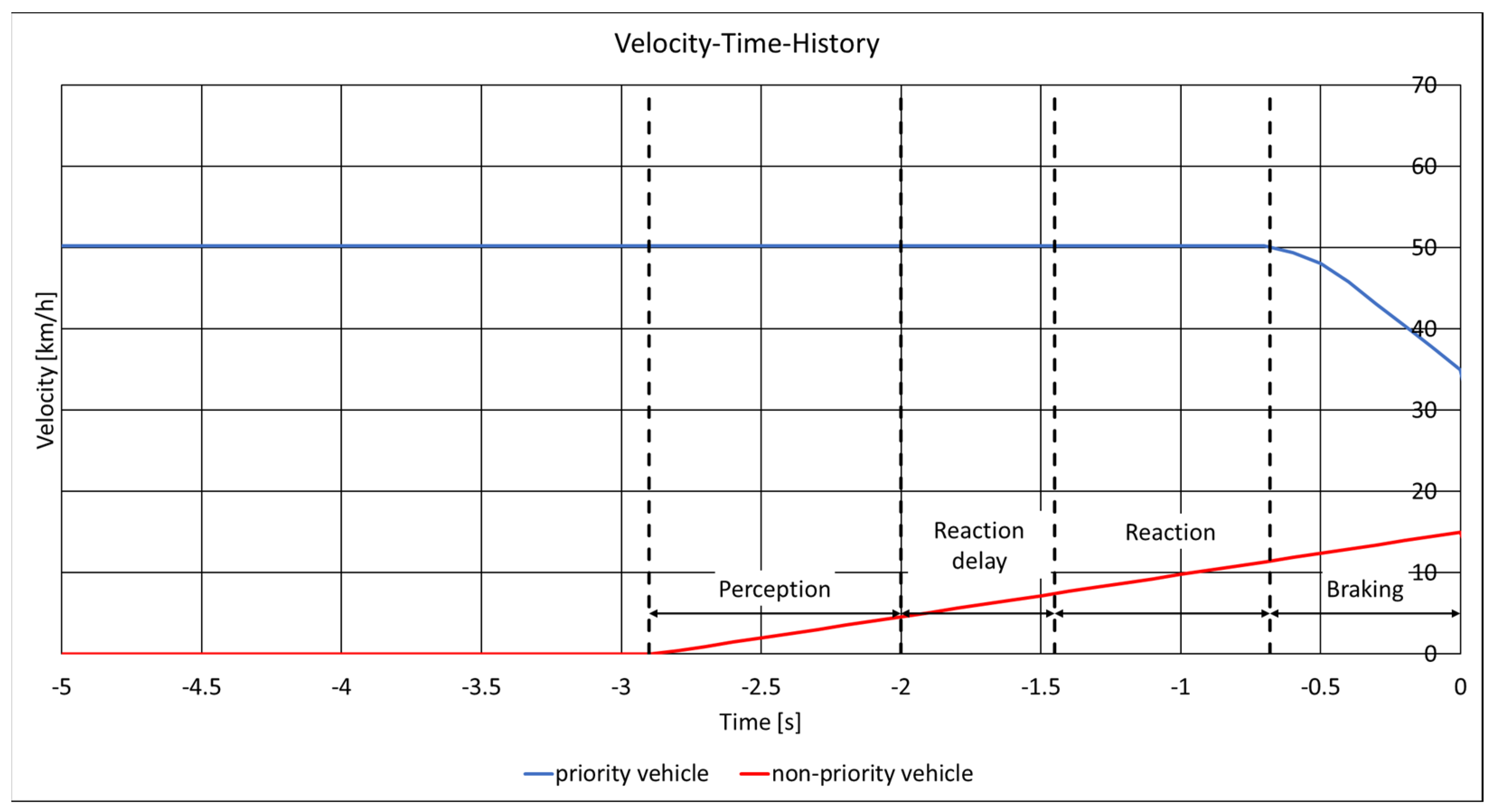

Appendix D.3. SCP Accidents
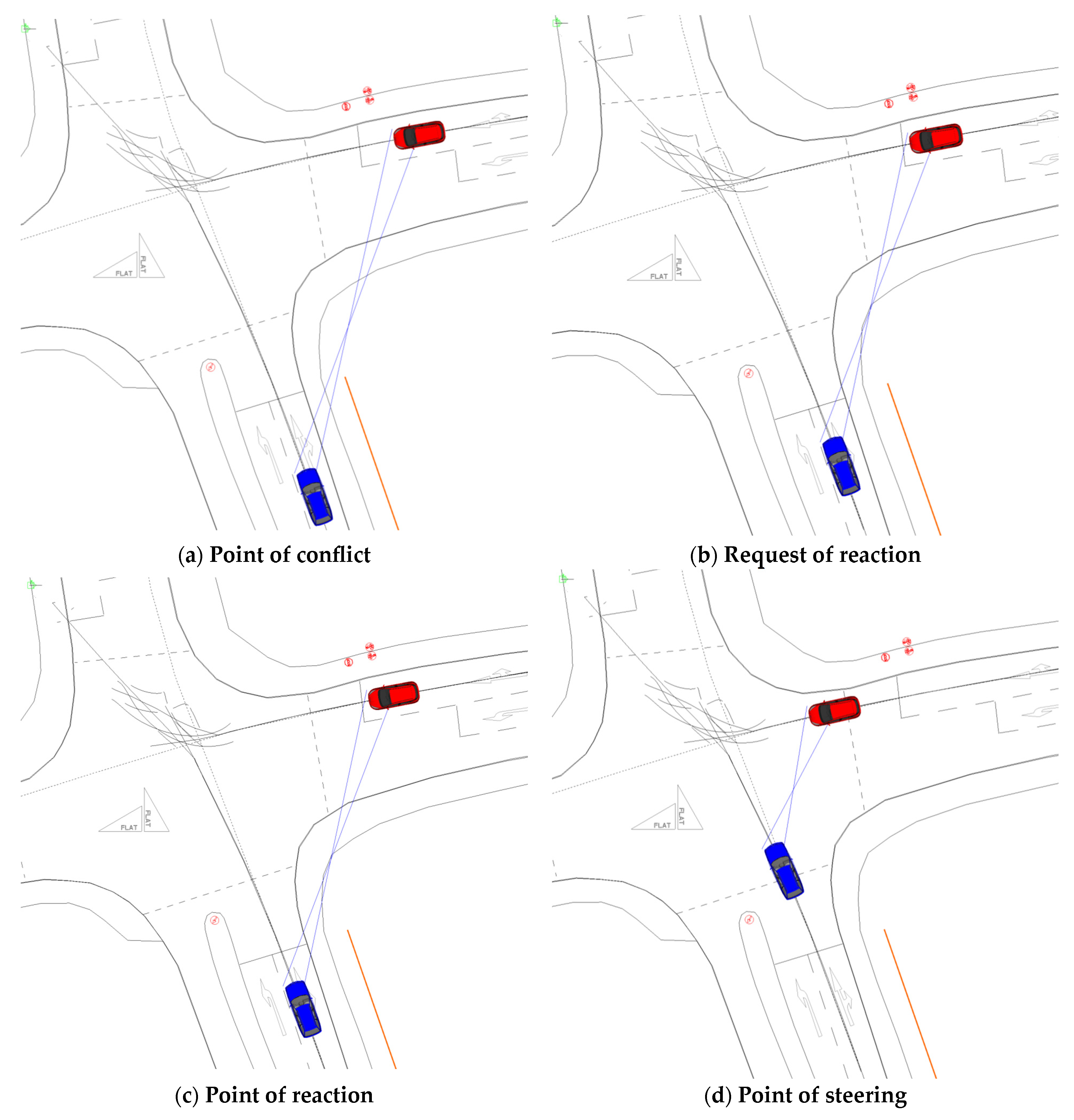
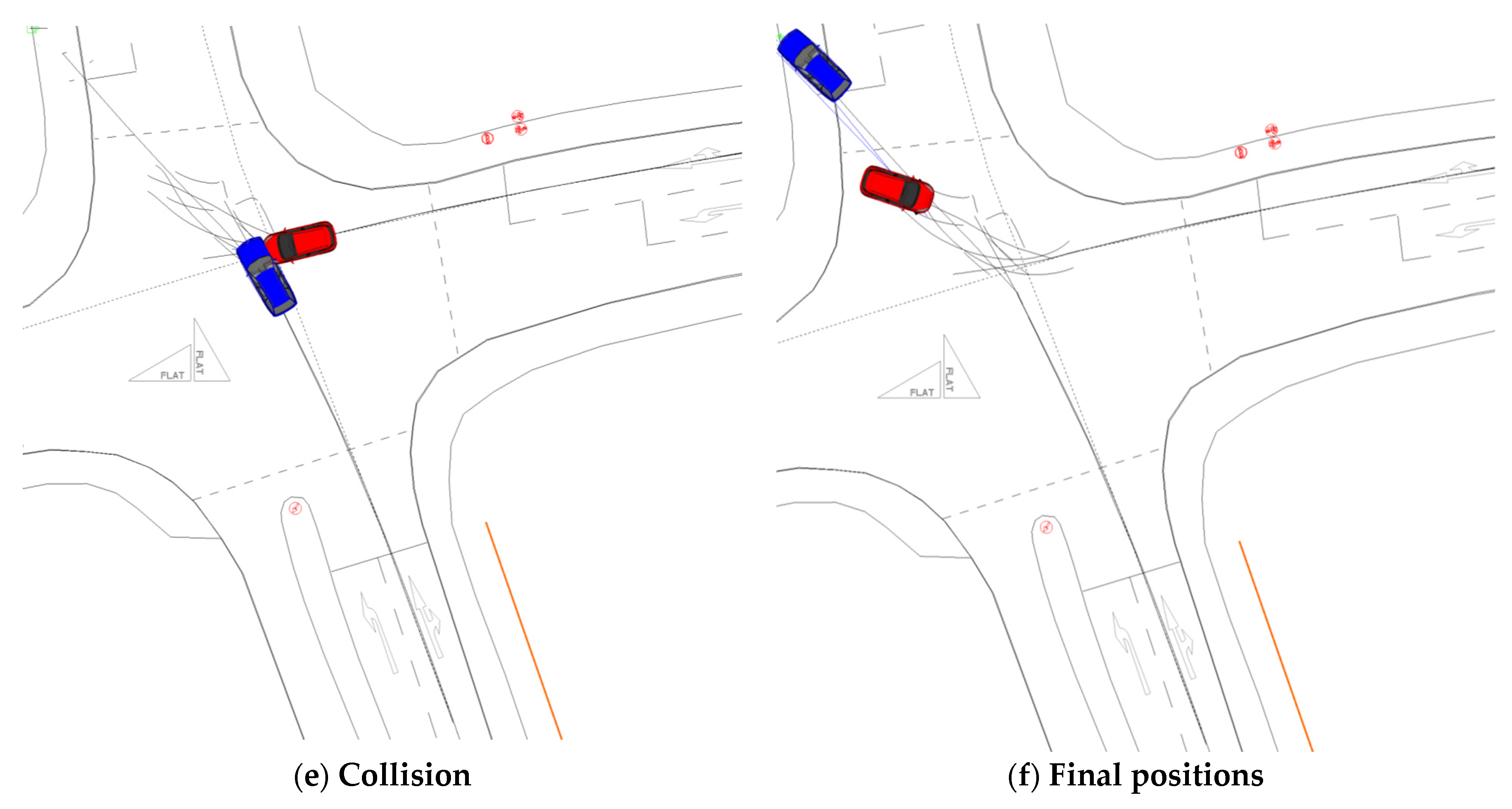
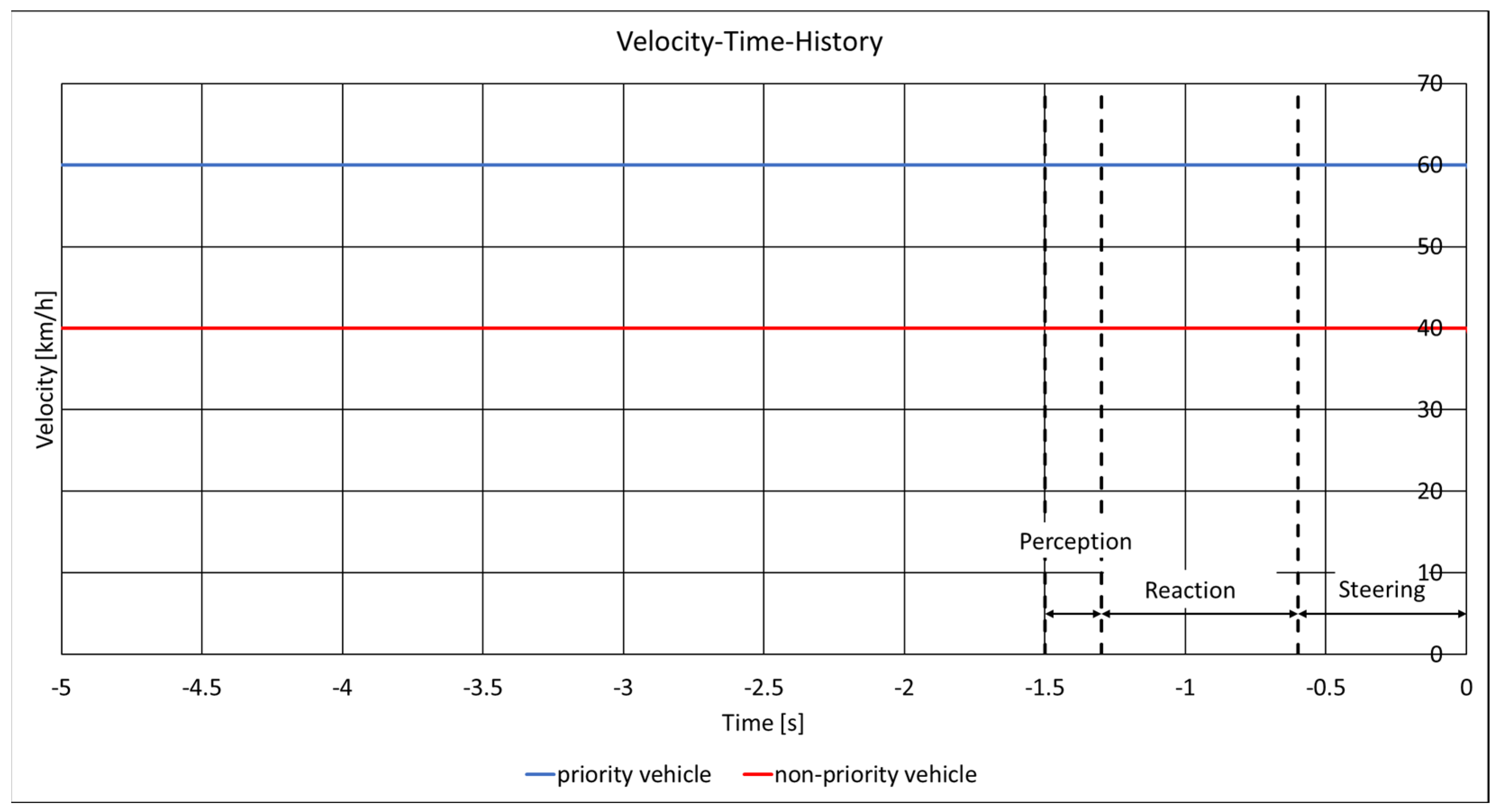
References
- Marshek, K.M.; Cuderman, J.F.; Johnson, M.J. Performance of Anti-Lock Braking System Equipped Passenger Vehicles-Part I: Braking as a Function of Brake Pedal Application Force; SAE Technical Paper: Warrendale, PA, USA, 2002. [Google Scholar]
- Scanlon, J.M.; Sherony, R.; Gabler, H.C. Preliminary potential crash prevention estimates for an Intersection Advanced Driver Assistance System in straight crossing path crashes. In Proceedings of the 2016 IEEE Intelligent Vehicles Symposium (IV), Gotenburg, Sweden, 19–22 June 2016; IEEE: New York, NY, USA, 2016; pp. 1135–1140. [Google Scholar]
- Chang, S.-H.; Lin, C.-Y.; Hsu, C.-C.; Fung, C.-P.; Hwang, J.-R. The effect of a collision warning system on the driving performance of young drivers at intersections. Transp. Res. Part F Traffic Psychol. Behav. 2009, 12, 371–380. [Google Scholar] [CrossRef]
- Scanlon, J.M.; Sherony, R.; Gabler, H.C. Injury mitigation estimates for an intersection driver assistance system in straight crossing path crashes in the United States. Traffic Inj. Prev. 2017, 18, S9–S17. [Google Scholar] [CrossRef]
- Scanlon, J.; Sherony, R.; Gabler, H. Preliminary Effectiveness Estimates for Intersection Driver Assistance Systems in LTAP/OD Crashes. In Proceedings of the FAST-Zero’17: 4th International Symposium on Future Active Safety Technology Toward Zero Traffic Accidents, Nara, Japan, 18–21 September 2017. [Google Scholar]
- Sander, U. Opportunities and limitations for intersection collision intervention-A study of real world ‘left turn across path’ accidents. Accid. Anal. Prev. 2017, 99, 342–355. [Google Scholar]
- Sander, U.; Lubbe, N. Market penetration of intersection AEB: Characterizing avoided and residual straight crossing path accidents. Accid. Anal. Prev. 2018, 115, 178–188. [Google Scholar] [CrossRef]
- Bareiss, M.; Scanlon, J.; Sherony, R.; Gabler, H.C. Crash and injury prevention estimates for intersection driver assistance systems in left turn across path/opposite direction crashes in the United States. Traffic Inj. Prev. 2019, 20, S133–S138. [Google Scholar]
- Zauner, C.; Tomasch, E.; Sinz, W.; Ellersdorfer, C.; Steffan, H. Assessment of the effectiveness of Intersection Assistance Systems at urban and rural accident sites. In Proceedings of the 6th International Conference on ESAR “Expert Symposium on Accident Research”, Hannover, Germany, 20–21 June 2014; ESAR: Thane, Mumbai, 2014. [Google Scholar]
- Spicer, R.; Vahabaghaie, A.; Bahouth, G.; Drees, L.; von Bülow, R.M.; Baur, P. Field effectiveness evaluation of advanced driver assistance systems. Traffic Inj. Prev. 2018, 19, S91–S95. [Google Scholar]
- Cicchino, J.B. Effectiveness of forward collision warning and autonomous emergency braking systems in reducing front-to-rear crash rates. Accid. Anal. Prev. 2017, 99, 142–152. [Google Scholar]
- Kim, Y.; Tak, S.; Kim, J.; Yeo, H. Identifying major accident scenarios in intersection and evaluation of collision warning system. In Proceedings of the IEEE ITSC 2017: 20th International Conference on Intelligent Transportation Systems, Yokohama, Japan, 16–19 October 2017; IEEE: Piscataway, NJ, USA, 2017; pp. 1–6. [Google Scholar]
- Liers, H.; Ungar, T. Prediction of the expected accident scenario of future Level 2 and Level 3 cars on German motorways. In Proceedings of the 2019 IRCOBI Conference, IRCOBI, Florence, Italy, 11–13 September 2019; International Research Council on the Biomechanics of Injury: Dublin, Ireland, 2019. [Google Scholar]
- HLDI. Predicted Availability of Safety Features on Registered Vehicles—A 2023 Update, 40th ed.; HLDI: Arlington, VA, USA, 2023. [Google Scholar]
- PARTS. Market Penetration of Advanced Driver Assistance Systems (ADAS); PARTS: NHTSA National Highway Traffic Safety Administration: Washington, DC, USA, 2024. [Google Scholar]
- Schram, R.; Aled, W.; van Ratingen, M.; Ryrber, S.; Sferco, R. Euro NCAP’S First Step to Assess Autonomous Emergency Braking (AEB) for Vulnerable Road Users. In Proceedings of the 24th ESV Conference Proceedings, Gothenburg, Sweden, 8–11 June 2015; National Highway Traffic Safety Administration (NHTSA): Washington, DC, USA, 2015. [Google Scholar]
- Euro NCAP. Assessment Protocol—Safety Assist Collision Avoidance; Euroncap: Brussels, Belgium, 2024. [Google Scholar]
- European Parliament And Council. Regulation (EU) 2019/2144 of the European Parliament and of the Council of 27 November 2019 on Type-Approval Requirements for Motor Vehicles and Their Trailers, and Systems, Components and Separate Technical Units Intended for Such Vehicles, as Regards Their General Safety and the Protection of Vehicle Occupants and Vulnerable Road Users; Regulation (EU) 2019/2144; European Parliament and Council: Brussels, Belgium, 2019. [Google Scholar]
- Scholliers, J.; Tarkiainen, M.; Silla, A.; Modijefsky, M.; Janse, R.; van den Born, G. Study on the Feasibility, Costs and Benefits of Retrofitting Advanced Driver Assistance to Improve Road Safety—Final Report; Directorate-General for Mobility and Transport: Brussels, Belgium, 2020. [Google Scholar]
- Tomasch, E.; Smit, S. Naturalistic driving study on the impact of an aftermarket blind spot monitoring system on the driver’s behaviour of heavy goods vehicles and buses on reducing conflicts with pedestrians and cyclists. Accid. Anal. Prev. 2023, 192, 107242. [Google Scholar]
- Pirkey, O.S. Signal for Automobiles. U.S. Patent No. 1,553,959, 15 September 1925. [Google Scholar]
- Douglass, S.F. Motor-Vehicle Signal. U.S. Patent No. 1,519,980, 16 December 1924. [Google Scholar]
- Radclyffe, B.B.; Fraser, R.P. Improvements in or Relating to Motor road Vehicles. Patent No. GB 493,510A, 1938. [Google Scholar]
- Post, D.V.; Mortimer, R.G. Subjective Evaluation of the Front-Mounted Braking Signal; University of Michigan, Highway Safety Research Institute: Ann Arbo, MI, USA, 1971. [Google Scholar]
- Petzoldt, T.; Schleinitz, K.; Banse, R. Potential safety effects of a frontal brake light for motor vehicles. IET Intell. Transp. Syst. 2018, 12, 449–453. [Google Scholar]
- Petzoldt, T.; Schleinitz, K.; Banse, R. Laboruntersuchung zur potenziellen Sicherheitswirkung einer vorderen Bremsleuchte in Pkw. ZVS-Z. Für Verkehrssicherheit 2017, 1, 19–24. [Google Scholar]
- Eisele, D.; Petzoldt, T. Effects of a frontal brake light on pedestrians’ willingness to cross the street. Transp. Res. Interdiscip. Perspect. 2024, 23, 100990. [Google Scholar] [CrossRef]
- Bluhm, L.-F.; Eisele, D.; Schubert, W.; Banse, R. Effects of a frontal brake light on (automated) vehicles on children’s willingness to cross the road. Transp. Res. Part F Traffic Psychol. Behav. 2023, 98, 269–279. [Google Scholar] [CrossRef]
- Monzel, M.; Keidel, K.; Schubert, W.; Banse, R. Feldstudie zur Erprobung einer Vorderen Bremsleuchte am Flughafen Berlin-Tegel. Z. Für Verkehrssicherheit 2018, 8, 1043–1052. [Google Scholar]
- Monzel, M.; Keidel, K.; Schubert, W.; Banse, R. A field study investigating road safety effects of a front brake light. IET Intell. Transp. Syst. 2021, 15, 1043–1052. [Google Scholar] [CrossRef]
- Poliak, M.; Culik, K.; Hajduk, I.; Kirschbaum, B. Psychological, safety and environmental impact of the Front Braking Light. AMS 2024, 29, 978–989. [Google Scholar]
- Poliak, M.; Frnda, J.; Čulík, K.; Kirschbaum, B. Impact of Front Brake Lights from a Pedestrian Perspective. Vehicles 2025, 7, 25. [Google Scholar] [CrossRef]
- Tomasch, E.; Steffan, H.; Darok, M. Retrospective accident investigation using information from court. In Proceedings of the TRA Transport Research Arena, Ljubljana, Slovenia, 21–24 April 2008; TRA: Dar es Salaam, Tanzania, 2008. [Google Scholar]
- Ross, R.; Thomas, P.; Sexton, B.; Otte, D.; Koßmann, I.; Vallet, G.; Martin, J.L.; Laumon, B.; Lejeune, P. An Approach to the Standardisation of Accident and Injury Registration Systems (STAIRS) in Europe. In Proceedings of the 16th ESV Conference, Windsor, ON, Canada, 31 May–4 June 1998; National Highway Traffic Safety Administration (NHTSA): Washington, DC, USA, 1998; pp. 1298–1305. [Google Scholar]
- Morris, A.; Thomas, P. PENDANT—Pan-European Coordinated Accident and Injury Databases. In Proceedings of the 18th ESV Conference Proceedings, Nagoya, Japan, 19–22 May 2003; National Highway Traffic Safety Administration (NHTSA): Washington, DC, USA, 2003. [Google Scholar]
- RISER. Roadside Infrastructure for Safer European Roads; Final Report; European Commission: Brussels, Belgium, 2006. [Google Scholar]
- Ockel, D.; Bakker, J.; Schöneburg, R. Internationale Harmonisierung von Unfalldaten: Fortschrittsbericht des FIA/ACEA Projekts iGLAD (Initiative for the Global Harmonization of Accident Data); VDI-Berichte 2144; VDI Verlag: Düsseldorf, Germany, 2011; pp. 301–309. [Google Scholar]
- Bakker, J.; Jeppson, H.; Hannawald, L.; Spitzhüttl, F.; Longton, A.; Tomasch, E. IGLAD—International Harmonized in-Depth Accident Data. In Proceedings of the 25th ESV Conference Proceedings, Detroit, MI, USA, 5–8 June 2017; National Highway Traffic Safety Administration (NHTSA): Washington, DC, USA, 2017. [Google Scholar]
- Liers, H.; Petzold, M.; Feifel, H.; Bakker, J.; Tomasch, E. The Creation and Application of Harmonized Pre-Crash Scenarios from Global Traffic Accident Data. In Proceedings of the 27th ESV Conference Proceedings, Yokohama, Japan, 3–6 April 2023; National Highway Traffic Safety Administration (NHTSA): Washington, DC, USA, 2023. [Google Scholar]
- Steffan, H.; PC-CRASH. A Simulation Program for Car Accidents. In Proceedings of the 26th International Symposium on Automotive Technology and Automation, Aachen, Germany, 13–17 September 1993. [Google Scholar]
- Bärgman, J.; Lisovskaja, V.; Victor, T.; Flannagan, C.; Dozza, M. How does glance behavior influence crash and injury risk? A ‘what-if’ counterfactual simulation using crashes and near-crashes from SHRP2. Transp. Res. Part F Traffic Psychol. Behav. 2015, 35, 152–169. [Google Scholar] [CrossRef]
- Wu, K.-F.; Ardiansyah, M.N.; Ye, W.-J. An evaluation scheme for assessing the effectiveness of intersection movement assist (IMA) on improving traffic safety. Traffic Inj. Prev. 2018, 19, 179–183. [Google Scholar] [CrossRef]
- Shichrur, R.; Ratzon, N.Z.; Shoham, A.; Borowsky, A. The Effects of an In-vehicle Collision Warning System on Older Drivers’ On-road Head Movements at Intersections. Front. Psychol. 2021, 12, 596278. [Google Scholar] [CrossRef]
- Chen, H.; Cao, L.; Logan, D.B. Investigation into the effect of an intersection crash warning system on driving performance in a simulator. Traffic Inj. Prev. 2011, 12, 529–537. [Google Scholar] [CrossRef] [PubMed]
- Lietz, H.; Petzoldt, T.; Henning, M.; Haupt, J.; Waniliek, G.; Krems, J.; Mosebach, H.; Schomerus, J.; Baumann, M.R.K.; Noyer, U. Methodische und technische Aspekte einer Naturalistic Driving Study. In FAT-Schriftenreihe 229; Verband der Automobilindustrie: Berlin, Germany, 2010. [Google Scholar]
- Dingus, T.A.; Klauer, S.G.; Neale, V.L.; Petersen, A.; Lee, S.E.; Sudweeks, J.; Perez, M.A.; Hankey, J.; Ramsey, D.; Gupta, S.; et al. The 100 Car Naturalistic Driving Study: Phase II—Results of the 100-Car Field Experiment; NHTSA: Washington, DC, USA, 2006. [Google Scholar]
- Blatt, A.; Pierowicz, J.; Flanigan, M.; Lin, P.-S.; Kourtellis, A.; Lee, C.; Jovanis, P.; Jenness, J.; Wilaby, M.; Campbell, J.; et al. Naturalistic Driving Study: Field Data Collection; Transportation Research Board: Washington, DC, USA, 2015. [Google Scholar]
- Hermitte, T.; Thomas, C.; Page, Y.; Perron, T. Real-World Car Accident Reconstruction Methods for Crash Avoidance System Research; SAE Technical Paper Series; SAE International: Warrendale, PA, USA, 2000. [Google Scholar]
- Orsini, F.; Gecchele, G.; Rossi, R.; Gastaldi, M. A conflict-based approach for real-time road safety analysis: Comparative evaluation with crash-based models. Accid. Anal. Prev. 2021, 161, 106382. [Google Scholar] [CrossRef] [PubMed]
- Steffan, H.; Moser, A. The Collision and Trajectory Models of PC-CRASH; International Congress & Exposition; SAE International: Warrendale, PA, USA, 1996. [Google Scholar]
- Cliff, W.E.; Montgomery, D.T. Validation of PC-Crash—A Momentum-Based Accident Reconstruction Program; SAE Technical Paper: Warrendale, PA, USA, 1996. [Google Scholar]
- Moser, A.; Hoschopf, H.; Steffan, H.; Kasanicky, G. Validation of the PC-Crash Pedestrian Model; SAE Technical Paper Series; SAE International: Warrendale, PA, USA, 2000. [Google Scholar]
- Rose, N.A.; Carter, N. An Analytical Review and Extension of Two Decades of Research Related to PC-Crash Simulation Software; SAE Technical Paper Series; SAE International: Warrendale, PA, USA, 2018. [Google Scholar]
- Steffan, H. Accident reconstruction methods. Veh. Syst. Dyn. 2009, 47, 1049–1073. [Google Scholar] [CrossRef]
- Burg, H.; Moser, A. Handbuch Verkehrsunfallrekonstruktion: Unfallaufnahme, Fahrdynamik, Simulation, 3rd ed.; Springer: Wiesbaden, Germany, 2017. [Google Scholar] [CrossRef]
- Johannsen, H. Unfallmechanik und Unfallrekonstruktion: Grundlagen der Unfallaufklärung, 3rd ed.; Springer Vieweg: Wiesbaden, Germany, 2013. [Google Scholar]
- Wille, J.; Zatloukal, M. rateEFFECT-Effectiveness evaluation of active safety systems. In Proceedings of the 5th International Conference on ESAR, Hannover, Germany, 7–8 September 2012; ESAR: Thane, Mumbai, 2012; pp. 1–41. [Google Scholar]
- Eichberger, A.; Rohm, R.; Hirschberg, W.; Tomasch, E.; Steffan, H. RCS-TUG Study: Benefit Potential Investigation of Traffic Safety Systems with Respect to Different Vehicle Categories. In Proceedings of the 22nd International Conference on the Enhanced Safety of Vehicles (ESV), Washington, DC, USA, 13–16 June 2011; pp. 1–13. [Google Scholar]
- Bazilinskyy, P.; Dodou, D.; de Winter, J. Survey on eHMI concepts: The effect of text, color, and perspective. Transp. Res. Part F Traffic Psychol. Behav. 2019, 67, 175–194. [Google Scholar] [CrossRef]
- Bazilinskyy, P.; Dodou, D.; de Winter, J. External Human-Machine Interfaces: Which of 729 Colors Is Best for Signaling ‘Please (Do not) Cross’? In Proceedings of the 2020 IEEE International Conference on Systems, Man, and Cybernetics (SMC), Toronto, ON, Canada, 11–14 October 2020; IEEE: Piscataway, NJ, USA, 2020; pp. 3721–3728. [Google Scholar]
- Bazilinskyy, P.; Kooijman, L.; Dodou, D.; de Winter, J.C.F. How should external human-machine interfaces behave? Examining the effects of colour, position, message, activation distance, vehicle yielding, and visual distraction among 1,434 participants. Appl. Ergon. 2021, 95, 103450. [Google Scholar] [CrossRef]
- Augenstein, J.; Perdeck, E.; Stratton, J.; Digges, K.; Bahouth, G. Characteristics of Crashes that Increase the Risk of Serious Injuries. Annu. Proc./Assoc. Adv. Automot. Med. 2003, 47, 561–576. [Google Scholar]
- Burckhardt, M. Reaktionszeiten bei Notbremsvorgängen; Verlag TÜV Rheinland: Köln, Germany, 1985. [Google Scholar]
- Olson, P.L.; Cleveland, D.E.; Fancher, P.S.; Schneider, L.W. Parameters Affecting Stopping Sight Distance; Transportation Research Board, University of Michigan Transportation Research Institute: Washington, DC, USA, 1984. [Google Scholar]
- Bäumler, H. Reaktionszeiten im Straßenverkehr. Verkehrsunfall und Fahrzeugtechnik: 2007; pp. 300–307. Available online: https://www.vkuonline.de/ (accessed on 6 December 2024).
- Bäumler, H. Reaktionszeiten im Straßenverkehr—Teil 2. Verkehrsunfall und Fahrzeugtechnik: 2007; pp. 334–340. Available online: https://www.vkuonline.de/reaktionszeiten-im-strassenverkehr-teil-2-1153974.html (accessed on 6 December 2024).
- Bäumler, H. Reaktionszeiten im Straßenverkehr3, Sachverständige. 2009; pp.78–83. Available online: https://widab.gerichts-sv.at/website2016/wp-content/uploads/2016/08/Sach-2009-78-83-Baeumler.pdf (accessed on 6 December 2024).
- Derichs, H. Vergleich Statistischer Auswerteverfahren der Experimentell Ermittelten Reaktionszeiten von PKW-Fahrern im Straßenverkehr. Master’s Thesis, Fachhochschule Köln, Cologne, Germany, 1998. [Google Scholar]
- Zoeller, H.; Hugemann, W. Zur Problematik der Bremsreaktionszeit im Strassenverkehr. 1999. Available online: https://trid.trb.org/view/960341 (accessed on 6 December 2024).
- Winninghoff, M.; Schmedding, K.; Schimmelpfennig, K.H. Die Reaktionszeitverlängerung bei Dunkelheit Unter Alkohol-und Blendungseinflüssen-Ergebnisse aus Laborversuchen. Verkehrsunfall und Fahrzeugtechnik: 2001 Volume 39, pp. 126–131. Available online: https://www.colliseum.eu/wiki/index.php?title=Die_Reaktionszeitverl%C3%A4ngerung_bei_Dunkelheit_unter_Alkohol-_und_Blendungseinfl%C3%BCssen_%E2%80%93_Ergebnisse_aus_Laborversuchen (accessed on 6 December 2024).
- Bäumler, H. Reaktionszeiten im Straßenverkehr. Verkehrsunfall und Fahrzeugtechnik: 2008, pp. 22–27. Available online: https://www.vkuonline.de/reaktionszeiten-im-strassenverkehr-teil-3-1153981.html (accessed on 6 December 2024).
- Green, M. “How Long Does It Take to Stop?”—Methodological Analysis of Driver Perception-Brake Times. Transp. Hum. Factors 2000, 2, 195–216. [Google Scholar] [CrossRef]
- Kaufman, S.; Buttenwieser, L. The State of Scooter Sharing in United States Cities. Available online: https://wagner.nyu.edu/files/faculty/publications/Rudin_ScooterShare_Aug2018_0.pdf (accessed on 6 December 2024).
- Hydén, C. The Development of a Method for Traffic Safety Evaluation: The Swedish Traffic Conflicts Technique; University of Lund, Lund Institute of Technology, Department of Traffic Planning and Engeneering: Lund, Sweden, 1987. [Google Scholar]
- European Commission. Annual statistical Report on Road Safety in the EU; European Commission: Brussels, Belgium, 2024. [Google Scholar]
- European Commission. Facts and Figures Junctions; European Commission: Brussels, Belgium, 2024. [Google Scholar]
- Simon, M.; Hermitte, T.; Page, Y. Intersection road accident causation: A European view. In Proceedings of the 21st ESV Conference Proceedings, Stuttgart, Germany, 15–18 June 2009; National Highway Traffic Safety Administration (NHTSA): Washington, DC, USA, 2009. [Google Scholar]
- Noland, R.B.; Oh, L. The effect of infrastructure and demographic change on traffic-related fatalities and crashes: A case study of Illinois county-level data. Accid. Anal. Prev. 2004, 36, 525–532. [Google Scholar] [CrossRef]
- Greibe, P. Accident prediction models for urban roads. Accid. Anal. Prev. 2003, 35, 273–285. [Google Scholar] [CrossRef]
- Gomes, S.V. The Influence of the Infrastructure Characteristics in Urban road Accidents Occurrence. Procedia-Soc. Behav. Sci. 2012, 48, 1611–1621. [Google Scholar] [CrossRef]
- Amare, V.; Smirnovs, J. Road Traffic Safety Analysis Of Different Junction Types On The State Roads. IOP Conf. Ser. Mater. Sci. Eng. 2021, 1202, 12034. [Google Scholar] [CrossRef]
- Wada, Y.; Asami, Y.; Hino, K.; Nishi, H.; Shiode, S.; Shiode, N. Road Junction Configurations and the Severity of Traffic Accidents in Japan. Sustainability 2023, 15, 2722. [Google Scholar] [CrossRef]
- Gitelman, V.; Doveh, E.; Carmel, R.; Pesahov, F. The Relationship Between Road Accidents and Infrastructure Characteristics of Low-Volume Roads in Israel. In Proceedings of the ICTTE: International Conference on Traffic and Transport Engineering, Belgrade, Serbia, 27–28 November 2014; Čokorilo, O., Ed.; City Net Scientific Research Center Ltd.: Belgrade, Serbia, 2014. [Google Scholar]
- Bener, A.; Al Maadid, M.G.A.; Özkan, T.; Al-Bast, D.A.E.; Diyab, K.N.; Lajunen, T. The impact of four-wheel drive on risky driver behaviours and road traffic accidents. Transp. Res. Part F Traffic Psychol. Behav. 2008, 11, 324–333. [Google Scholar] [CrossRef]
- Rhodes, N.; Pivik, K. Age and gender differences in risky driving: The roles of positive affect and risk perception. Accid. Anal. Prev. 2011, 43, 923–931. [Google Scholar] [CrossRef] [PubMed]
- Russo, F.; Biancardo, S.A.; Dell, G. Road safety from the perspective of driver gender and age as related to the injury crash frequency and road scenario. Traffic Inj. Prev. 2014, 15, 25–33. [Google Scholar] [CrossRef]
- Xu, J.; Guo, K.; Sun, P.Z.H. Driving Performance Under Violations of Traffic Rules: Novice vs. Experienced Drivers. IEEE Trans. Intell. Veh. 2022, 7, 908–917. [Google Scholar] [CrossRef]
- Chen, H.Y.; Senserrick, T.; Chang, H.Y.; Ivers, R.Q.; Martiniuk, A.L.C.; Boufous, S.; Norton, R. Road crash trends for young drivers in New South Wales, Australia, from 1997 to 2007. Traffic Inj. Prev. 2010, 11, 8–15. [Google Scholar] [CrossRef]
- Statistik Austria, Unfalldatenmanagement (UDM). Available online: www.statistik.at (accessed on 2 December 2024).

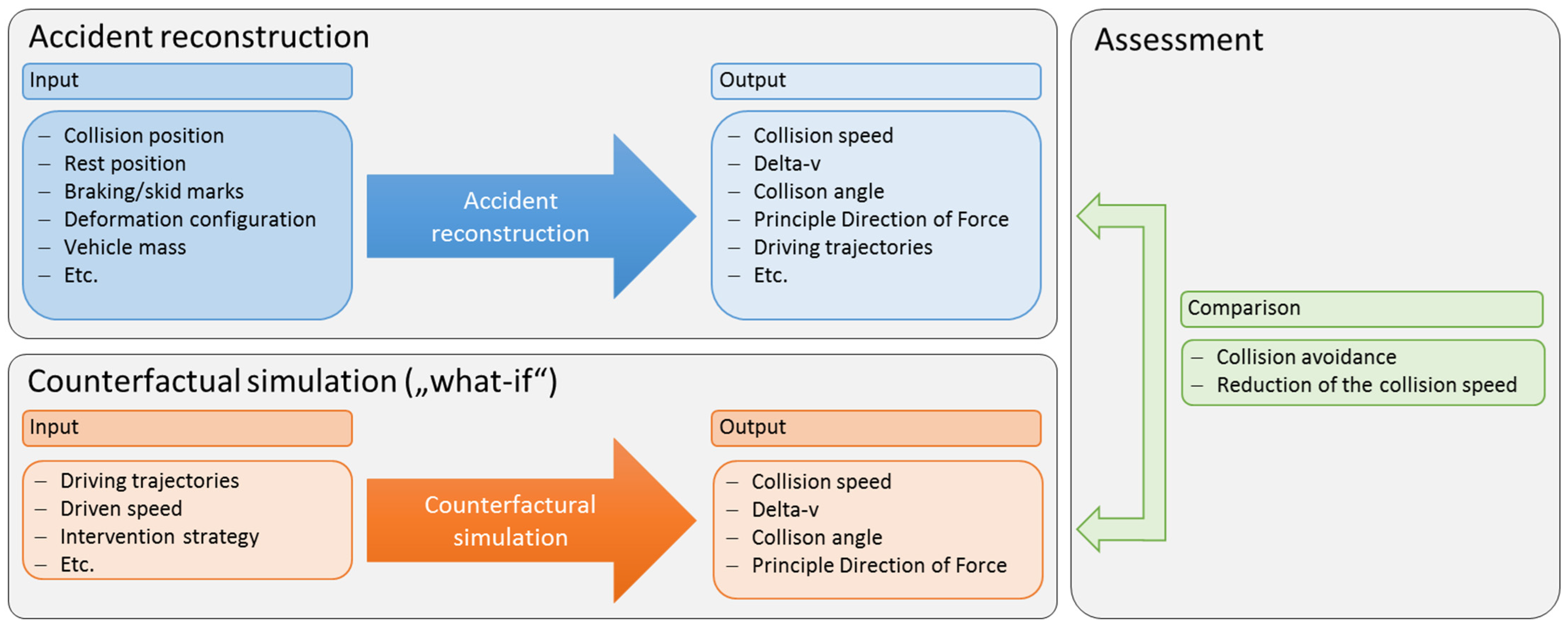

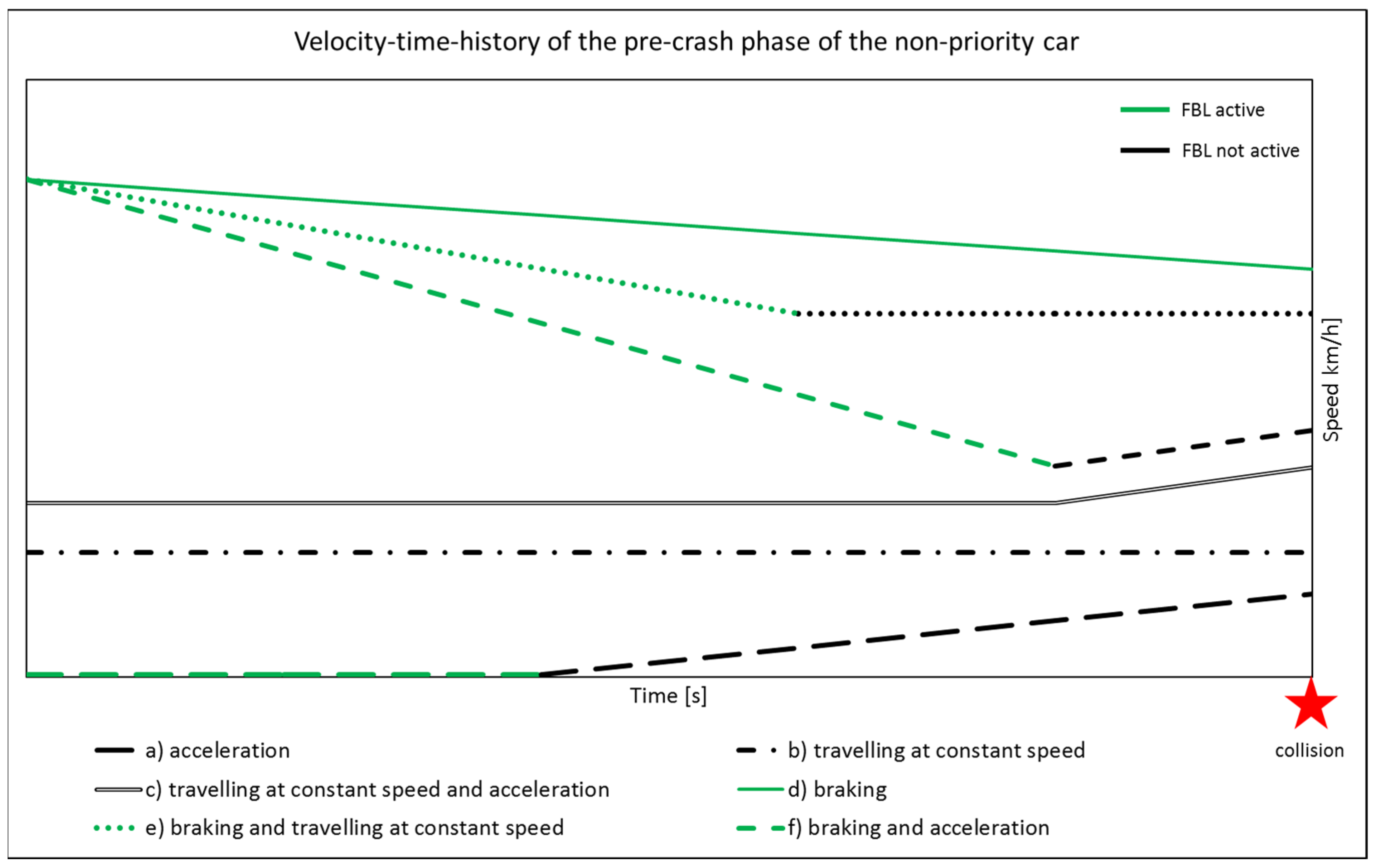

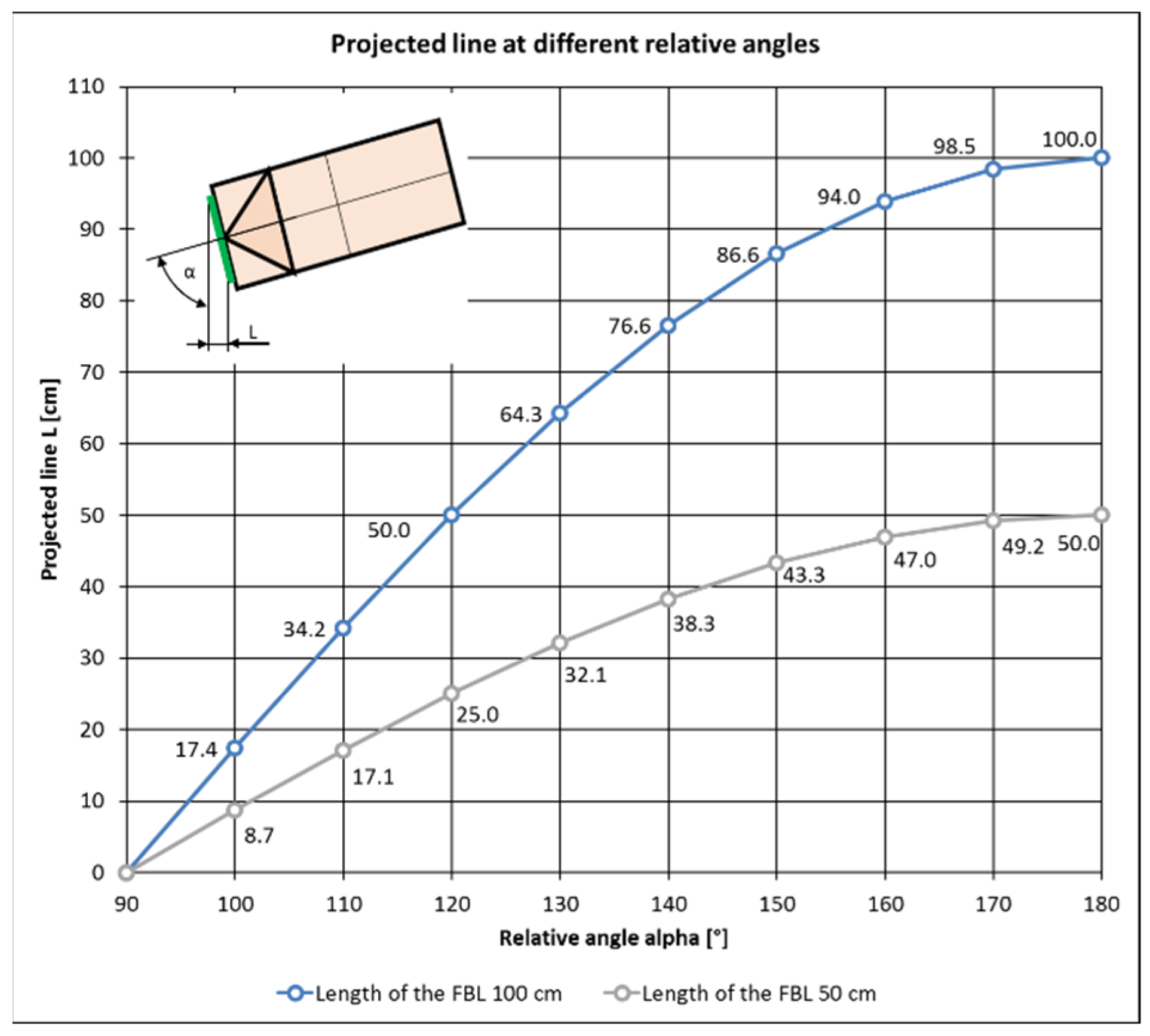
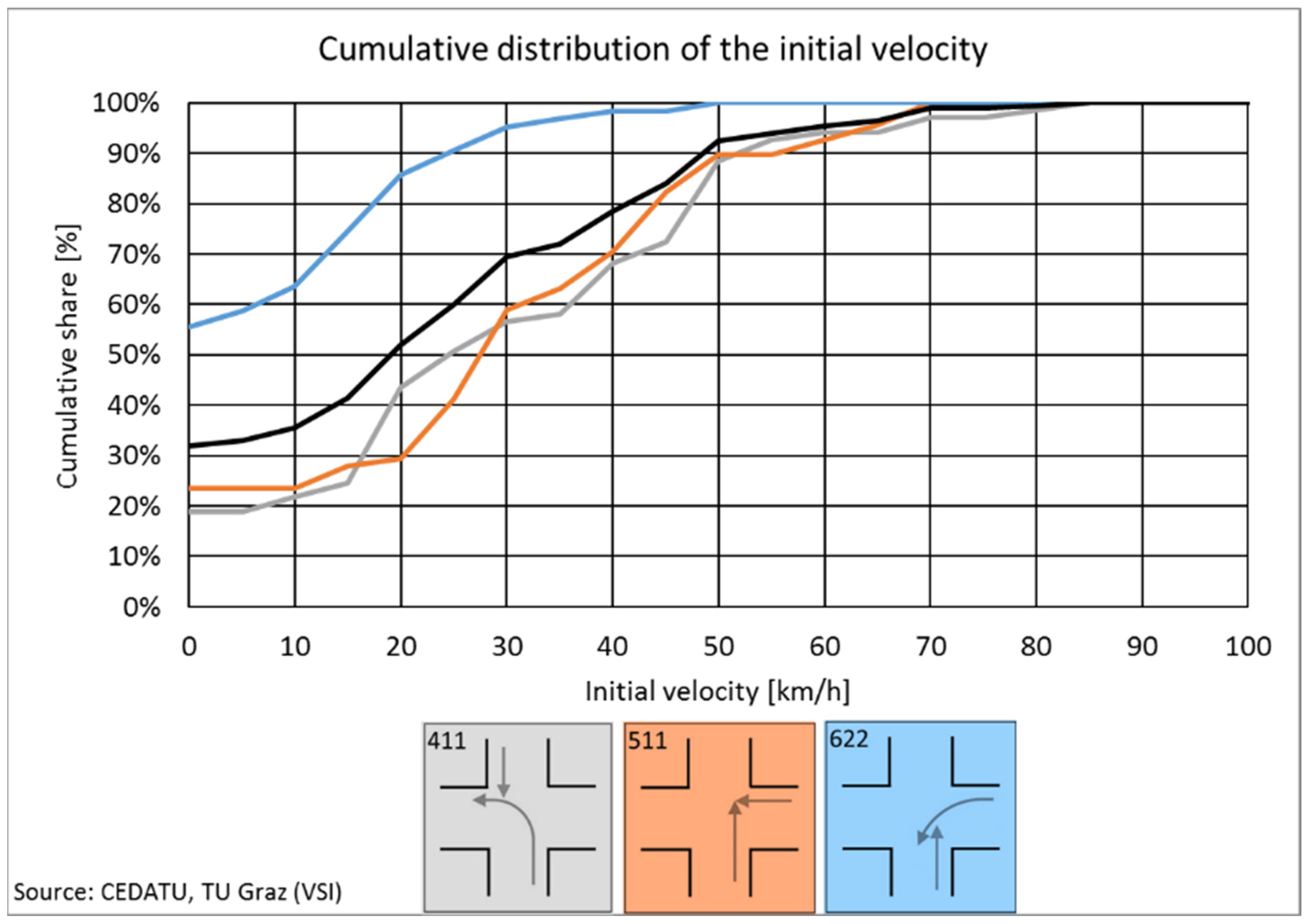

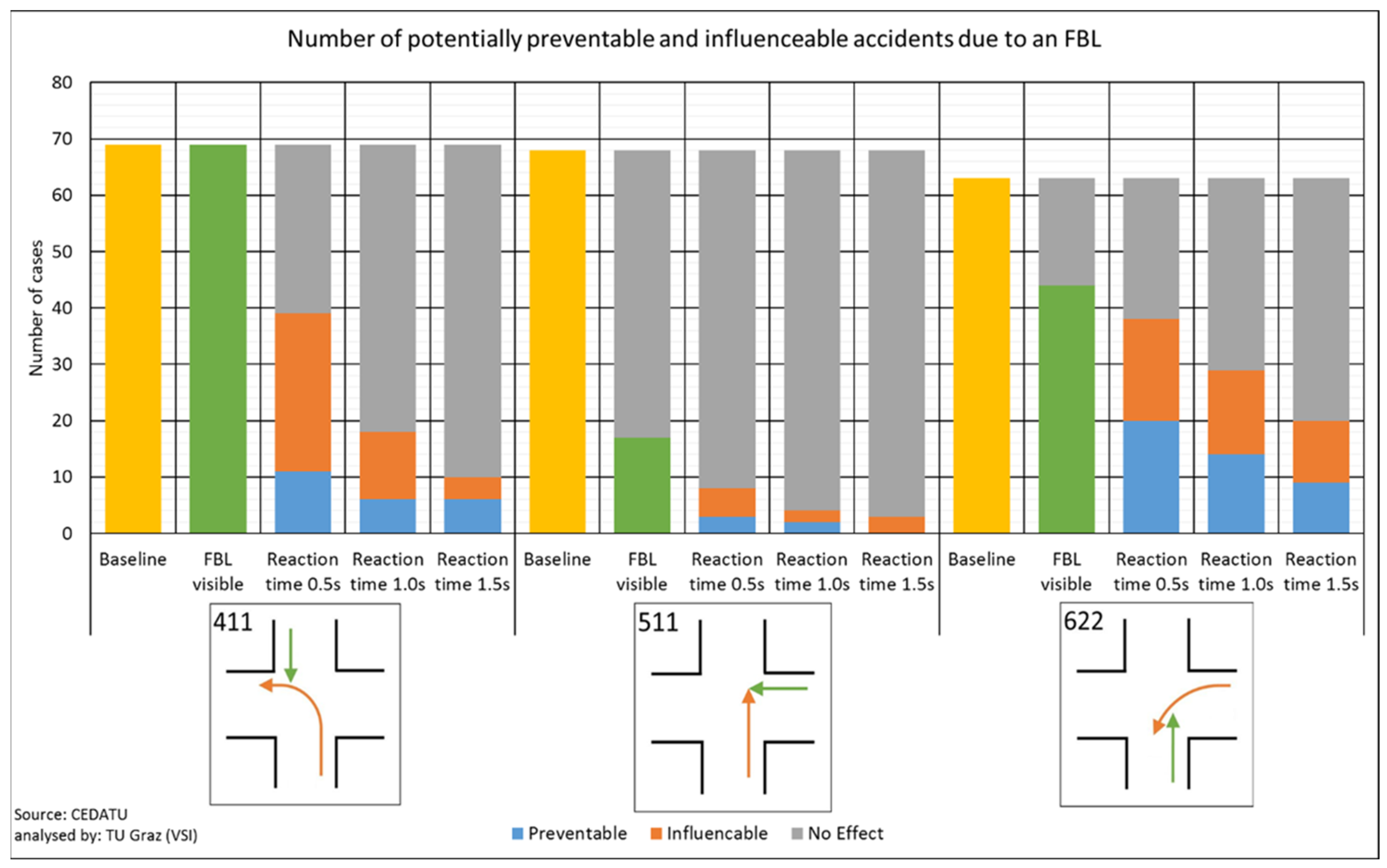

| Minor Injury | Severe Injury | Fatal Injury | Total | |||||
|---|---|---|---|---|---|---|---|---|
| Urban | Rural | Urban | Rural | Urban | Rural | Urban | Rural | |
| 411 (LTAP/OD) | 27 | 13 | 10 | 9 | 3 | 7 | 40 | 29 |
| 511 (SCP) | 35 | 2 | 11 | 9 | 1 | 10 | 47 | 21 |
| 622 (LTAP/LD) | 20 | 13 | 3 | 14 | 2 | 11 | 25 | 38 |
| Total | 82 | 28 | 24 | 32 | 6 | 28 | 112 | 88 |
| LTAP/OD | SCP | LTAP/LD | Total | |
|---|---|---|---|---|
| Braking | 30 | 12 | 12 | 54 |
| Acceleration | 15 | 18 | 35 | 68 |
| Constant speed | 24 | 38 | 16 | 78 |
| Total | 69 | 68 | 63 | 200 |
| Accident Site | Safety Performance | Reaction Time 0.5 s | Reaction Time 1.0 s | Reaction Time 1.5 s |
|---|---|---|---|---|
| Urban | Baseline | 112 | 112 | 112 |
| FBL visible | 67 | 67 | 67 | |
| Preventable | 28 | 20 | 12 | |
| Influenceable | 43 | 21 | 13 | |
| No effect | 41 | 71 | 87 | |
| Rural | Baseline | 88 | 88 | 88 |
| FBL visible | 63 | 63 | 63 | |
| Preventable | 23 | 15 | 10 | |
| Influenceable | 33 | 23 | 15 | |
| No effect | 32 | 50 | 63 |
| Accident Site | Safety Performance | Reaction Time 0.5 s | Reaction Time 1.0 s | Reaction Time 1.5 s |
|---|---|---|---|---|
| Dry road | Baseline | 148 | 148 | 148 |
| FBL visible | 97 | 97 | 97 | |
| Preventable | 41 | 29 | 19 | |
| Influenceable | 52 | 30 | 20 | |
| No effect | 55 | 89 | 109 | |
| Adverse road (wet, snow/snow slush) | Baseline | 52 | 52 | 52 |
| FBL visible | 33 | 33 | 33 | |
| Preventable | 10 | 6 | 3 | |
| Influenceable | 24 | 14 | 8 | |
| No effect | 18 | 32 | 41 |
| Accident Site | Safety Performance | Reaction Time 0.5 s | Reaction Time 1.0 s | Reaction Time 1.5 s |
|---|---|---|---|---|
| Daylight | Baseline | 143 | 143 | 143 |
| FBL visible | 94 | 94 | 94 | |
| Preventable | 35 | 26 | 15 | |
| Influenceable | 54 | 30 | 20 | |
| No effect | 54 | 87 | 108 | |
| Darkness, Twilight/Dawn | Baseline | 35 | 35 | 35 |
| FBL visible | 26 | 26 | 26 | |
| Preventable | 9 | 5 | 4 | |
| Influenceable | 15 | 9 | 5 | |
| No effect | 11 | 21 | 26 | |
| Artificial light | Baseline | 22 | 22 | 22 |
| FBL visible | 10 | 10 | 10 | |
| Preventable | 7 | 4 | 3 | |
| Influenceable | 7 | 5 | 3 | |
| No effect | 8 | 13 | 16 |
| Injury Severity | Cases | Baseline | Reaction Time 0.5 s | Reaction Time 1.0 s | Reaction Time 1.5 s | |
|---|---|---|---|---|---|---|
| Minor | All | 110 | 44.8 (15.9) | 28.8 (23.4) | 36.3 (23.5) | 41.6 (22.2) |
| FBL visible | 72 | 46.4 (16.6) | 27.7 (24.3) | 36.3 (24.7) | 42.6 (23.5) | |
| Severe | All | 56 | 56.2 (24.3) | 36.9 (30.1) | 45.2 (31.3) | 49.2 (33.5) |
| FBL visible | 35 | 60.0 (25.9) | 41.3 (32.3) | 50.1 (32.8) | 54.1 (35.6) | |
| Fatal | All | 34 | 70.9 (20.5) | 51.2 (31.9) | 59.9 (32.0) | 69.6 (23.6) |
| FBL visible | 23 | 69.7 (21.0) | 54.3 (31.4) | 62.4 (33.3) | 72.4 (24.4) | |
| Injury Severity | Cases | Car | Baseline | Reaction Time 0.5 s | Reaction Time 1.0 s | Reaction Time 1.5 s |
|---|---|---|---|---|---|---|
| Minor | 72 | priority | 20.2 (10.2) | 12.3 (12.2) | 15.6 (12.5) | 18.1 (12.8) |
| non-priority | 20.6 (10.4) | 12.5 (12.6) | 15.8 (13.1) | 18.1 (13.2) | ||
| Severe | 35 | priority | 29.7 (12.7) | 18.9 (16.4) | 22.5 (17.0) | 22.6 (16.6) |
| non-priority | 31.0 (15.0) | 20.5 (18.6) | 24.8 (19.6) | 24.8 (19.6) | ||
| Fatal | 23 | priority | 35.4 (14.6) | 26.8 (18.1) | 32.4 (20.9) | 37.3 (18.5) |
| non-priority | 44.4 (19.1) | 34.3 (23.2) | 40.3 (24.6) | 45.4 (20.4) | ||
| Total | 130 | priority | 25.5 (13.2) | 16.6 (15.4) | 20.4 (16.6) | 22.7 (16.5) |
| non-priority | 27.6 (16.2) | 18.5 (18.3) | 22.5 (19.6) | 24.7 (19.1) |
| Accident Type | Injury Severity | Safety Performance | Reaction Time 0.5 s | Reaction Time 1.0 s | Reaction Time 1.5 s |
|---|---|---|---|---|---|
| LTAP/OD | Minor injury | Preventable | 95 | 41 | 41 |
| Influenceable | 244 | 109 | 55 | ||
| Severe injury | Preventable | 15 | 11 | 11 | |
| Influenceable | 19 | 11 | 0 | ||
| Fatal injury | Preventable | 0 | 0 | 0 | |
| Influenceable | 1 | 1 | 0 | ||
| SCP | Minor injury | Preventable | 64 | 64 | 0 |
| Influenceable | 96 | 32 | 96 | ||
| Severe injury | Preventable | 6 | 0 | 0 | |
| Influenceable | 11 | 6 | 0 | ||
| Fatal injury | Preventable | 0 | 0 | 0 | |
| Influenceable | 0 | 0 | 0 | ||
| LTAP/LD | Minor injury | Preventable | 173 | 107 | 80 |
| Influenceable | 80 | 120 | 80 | ||
| Severe injury | Preventable | 10 | 10 | 10 | |
| Influenceable | 16 | 10 | 4 | ||
| Fatal injury | Preventable | 1 | 1 | 0 | |
| Influenceable | 1 | 1 | 1 | ||
| Total | Minor injury | Preventable | 332 | 212 | 121 |
| Influenceable | 420 | 261 | 231 | ||
| Severe injury | Preventable | 31 | 21 | 21 | |
| Influenceable | 46 | 27 | 4 | ||
| Fatal injury | Preventable | 1 | 1 | 0 | |
| Influenceable | 2 | 2 | 1 |
Disclaimer/Publisher’s Note: The statements, opinions and data contained in all publications are solely those of the individual author(s) and contributor(s) and not of MDPI and/or the editor(s). MDPI and/or the editor(s) disclaim responsibility for any injury to people or property resulting from any ideas, methods, instructions or products referred to in the content. |
© 2025 by the authors. Licensee MDPI, Basel, Switzerland. This article is an open access article distributed under the terms and conditions of the Creative Commons Attribution (CC BY) license (https://creativecommons.org/licenses/by/4.0/).
Share and Cite
Tomasch, E.; Kirschbaum, B.; Schubert, W. Assessment of the Potential of a Front Brake Light to Prevent Crashes and Mitigate the Consequences of Crashes at Junctions. Vehicles 2025, 7, 40. https://doi.org/10.3390/vehicles7020040
Tomasch E, Kirschbaum B, Schubert W. Assessment of the Potential of a Front Brake Light to Prevent Crashes and Mitigate the Consequences of Crashes at Junctions. Vehicles. 2025; 7(2):40. https://doi.org/10.3390/vehicles7020040
Chicago/Turabian StyleTomasch, Ernst, Bernhard Kirschbaum, and Wolfgang Schubert. 2025. "Assessment of the Potential of a Front Brake Light to Prevent Crashes and Mitigate the Consequences of Crashes at Junctions" Vehicles 7, no. 2: 40. https://doi.org/10.3390/vehicles7020040
APA StyleTomasch, E., Kirschbaum, B., & Schubert, W. (2025). Assessment of the Potential of a Front Brake Light to Prevent Crashes and Mitigate the Consequences of Crashes at Junctions. Vehicles, 7(2), 40. https://doi.org/10.3390/vehicles7020040






